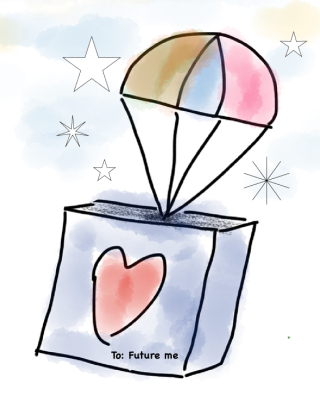Identity
The Ultimate Guide to Becoming Friends With Your Future Self
Most of us say we care about our future, yet our daily choices don’t always show it. Becoming friends with your future self means treating that person as real, vivid, and worth protecting today. When you do, saving, exercising, learning, and nurturing relationships stop feeling like chores and start feeling like gifts.
The Research Hook: Why Your Future Self Feels Like a Stranger
Psychologists have found that many people relate to their future self the way they relate to a different person entirely. That distance explains why we procrastinate, overspend, scroll late at night, or say “I’ll start Monday” and never do.
When your future self feels unreal, long-term decisions feel optional.
In 2025, this gap is amplified by constant notifications, one-click shopping, and instant entertainment. Our environment is engineered for now, not later. The good news: you can deliberately close that gap and turn your future self into someone you feel responsible for—and excited to support.
The Science of Becoming Friends With Your Future Self
At the core of becoming friends future is the idea of "future-self continuity": the sense that who you’ll be in 5, 10, or 30 years is meaningfully connected to who you are today.
When continuity is high:
- You save more for long-term goals.
- You’re more likely to exercise, sleep well, and eat mindfully.
- You make more ethical and prosocial choices.
When continuity is low:
- You treat your future self like a stranger “who can deal with it later.”
- Impulsive decisions feel justified.
- Long-term regret becomes more likely.
This is not about perfection or rigid discipline. It’s about empathy for your future self, so present choices feel aligned, not conflicted.
The Latest Research (2021–2024): What Studies Reveal
Researchers across psychology and behavioral science have clarified how we experience our future selves:
- Oliver Burkeman (2021) highlights that we have roughly 4,000 weeks of life, reframing time as a finite, precious resource rather than an infinite backdrop.
- Hal Hershfield (2023) shows that when people vividly picture their future selves—through images, letters, or guided reflection—they save more, plan better, and act more kindly toward that future version.
- Chu & Lowery (2023) find that perceiving a relatively stable self over time is linked with higher meaning in life, even as we grow and change.
- Harvard (2024) reports that brief future-visualization exercises (as short as 2–3 minutes) increase follow-through on health behaviors and studying, particularly when the future self feels emotionally similar.
- Stanford researchers have noted that aligning short-term rewards (such as immediate satisfaction or small milestones) with long-term goals significantly improves consistency in habit formation.
Together, these findings suggest a powerful message: the more real your future self feels, the easier it becomes to act in their best interest today.
Evidence-Based Mechanisms: Why Our Present vs. Future Gets Confused
Several psychological mechanisms shape how we treat our future selves:
- Present bias: We prioritize immediate comfort (scrolling, snacks, shortcuts) over distant benefits.
- Hyperopia: We over-focus on maximizing the future and under-enjoy the present, deferring joy endlessly.
- Identity drift: As we recognize how much we’ve changed before, we assume our future self is a different person—so we discount their needs.
- Emotional distance: If you can’t feel what future-you will feel, their outcomes don’t fully register.
The goal is not to choose present or future, but to connect them—so that what feels good now also supports who you’re becoming.
People Also Ask: What Does It Mean to Be Friends With Your Future Self?
Being friends with your future self means seeing them as continuous with who you are now, and acting with loyalty, care, and respect toward that version of you. You make decisions your future self will thank you for—not resent—while still allowing yourself joy, rest, and meaning in the present.
People Also Ask: How Do I Visualize My Future Self Effectively?
To visualize your future self effectively, picture a specific age, setting, and lifestyle, then connect it to your current habits. Focus on how that version of you feels—health, relationships, purpose—rather than only achievements. The more vivid and emotionally grounded the image, the more motivating it becomes.
People Also Ask: Is Focusing on the Future Bad for Present Happiness?
Focusing only on the future can backfire. When happiness is constantly postponed, everyday life becomes a waiting room. The research suggests a balanced approach: choose actions that feel meaningful now and also benefit later. Present joy and future responsibility can—and should—coexist.

Research-Backed Strategies: 7 Proven Ways to Connect With Future You
These strategies integrate current science on behavior change, identity, and well-being.
1. Write a Two-Way Letter Between Present and Future You
Write a letter to yourself 1–5 years ahead describing your life, fears, habits, and hopes. Then, write a reply from that future self with advice, reassurance, and specific requests.
- Ask: "What do you wish I’d start doing this month?"
- Ask: "What tiny habit today would make your life easier?"
This exercise increases future-self vividness and has been linked to better financial and health decisions (Hershfield, 2023).
2. Identify Your Non-Negotiable Constants
Even as circumstances change, some parts of you stay relatively stable—your values, your sense of humor, your care for certain people.
- List 3 values you want to remain true in 10 years (e.g., integrity, curiosity, kindness).
- Let these guide your choices more than trends, pressure, or moods.
Perceiving this stability, as Chu & Lowery (2023) suggest, fuels meaning, direction, and calmer decision-making amid uncertainty.
3. Create a Vivid Best-Future-Self Snapshot
Set a timer for 5 minutes and imagine your best realistic life 5 years from now:
- Where are you living?
- How do you take care of your body?
- Who are you close to?
- What kind of work or contribution are you proud of?
Then identify 1–3 obstacles between today and that snapshot that are actually changeable—like sleep, clutter, screen time, or unspoken conversations. Tie one tiny action today (a 10-minute walk, one honest message, one saved dollar) to that vision.
When sacrifices become acts of loyalty to your future self, discipline feels less like punishment and more like self-respect.
4. Use "Elder Perspective" for Fast Clarity
Imagine yourself at 80, looking back on this exact season.
Ask:
- "What will I be proud I started now?"
- "What will I regret postponing?"
- "What ‘urgent’ things won’t matter at all?"
This mental time travel often sharpens priorities more effectively than any productivity hack and supports values-aligned decision-making (Harvard, 2024).
5. Track How You’ve Already Changed
Look back 3–10 years:
- How have your habits, friendships, fears, and goals shifted?
- Which changes made life better? Which made it heavier?
Notice two truths at once: you’ve changed a lot, and a recognizable "you" has remained. This balanced view reduces anxiety about the future and supports wiser long-term commitments.
6. Design Friction for Impulses, Ease for Future-Friendly Choices
Stanford researchers highlight that shaping your environment often beats relying on willpower.
Try:
- Put your phone in another room at night; place a book or journal by your bed.
- Keep healthy snacks at eye level and treats less accessible.
- Turn saving into an automatic transfer so "future-you" gets paid without daily decisions.
These cues make future-benefiting behaviors the path of least resistance.
7. Practice Small Daily Acts of Kindness to Future You
Think of becoming friends future as a series of micro-gifts:
- Laying out clothes for tomorrow.
- Leaving clear notes for Monday-you before logging off.
- Cleaning the kitchen at night so morning-you walks into calm.
These acts may seem small, but they compound into a powerful identity shift: "I am someone who looks out for myself."

Meta-Analysis Insights: What Works Best Over Time
Across multiple lines of evidence and reviews in behavioral science, several themes consistently show up as effective:
- Techniques that make the future self vivid (visualization, letters, age-progressed images) improve long-term planning.
- Implementation intentions ("If X happens, then I will do Y") increase follow-through on goals supporting future you.
- Values clarification and self-continuity both strengthen resilience and reduce regret.
Summarized simply: seeing, planning, and caring for your future self—while honoring your present needs—predicts better health, finances, and life satisfaction.
Practical Implementation: A 7-Day Future-Self Alignment Plan
Use this simple, mobile-friendly plan to start today.
Day 1: Define Future You
- Write 5 bullet points describing you in 3 years.
- Highlight 2 traits you’re proud to grow.
Day 2: One Letter, Ten Minutes
- Write a one-page letter to your future self.
- Seal it in your notes app or journal with a read date.
Day 3: Remove One Friction
- Choose one habit (sleep, movement, study, saving).
- Adjust your environment to make the habit 20% easier.
Day 4: Present Joy Check
- List 3 ways to enjoy today that don’t sabotage tomorrow.
- Schedule at least one.
Day 5: Elder Self Question
- Ask: "What would 80-year-old me tell me to start or stop?"
- Take one small step.
Day 6: Money or Health Micro-Gift
- Save a small amount or choose one healthier option.
- Say, "This is for you," to your future self.
Day 7: Review & Commit
- Reflect on which actions felt right.
- Commit to 1–2 sustainable habits for the next month.
Expert Recommendations for 2025 and Beyond
Leading psychologists and behavior experts increasingly recommend:
- Build systems, not heroic bursts. Automate what matters to your future self.
- Pair every long-term habit with a short-term win (energy, pride, enjoyment).
- Revisit your future-self vision quarterly; update it as you grow.
- Talk to yourself with the same tone you’d use for a close friend you love.
The most powerful mindset shift: "Future me is not a stranger. They are me. They deserve my kindness today."

The Golden Thread: Living Well Across Past, Present, and Future
Your identity is not a single fixed self, but a story woven over time. Like kintsugi—where cracks are repaired with gold—your changes, detours, and repairs can create something more meaningful, not less.
Becoming friends future is about recognizing the golden thread that runs through:
- The child you once were.
- The person reading this now.
- The older you who will live with the results.
With only a "few thousand weeks" to work with, the question becomes practical and urgent:
What can you do today—small, kind, and consistent—that your future self will look back on with gratitude instead of regret?
Start there.





